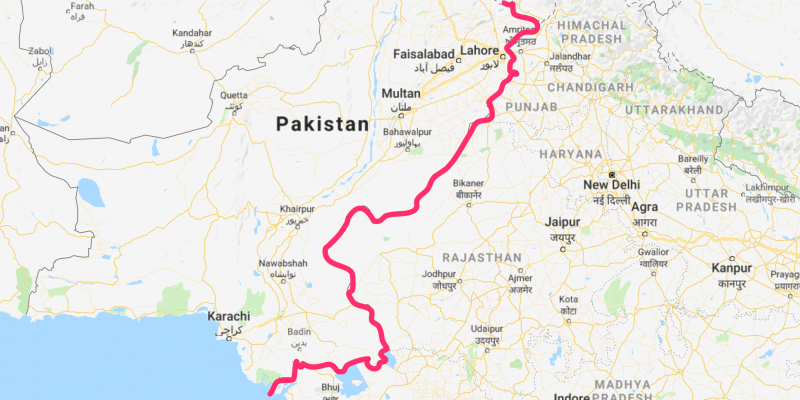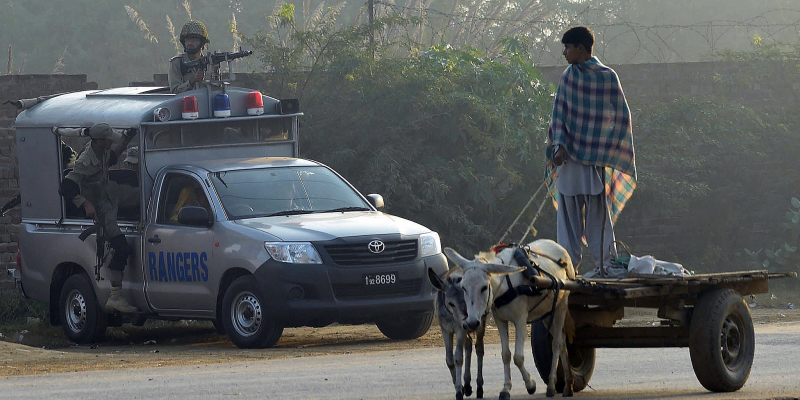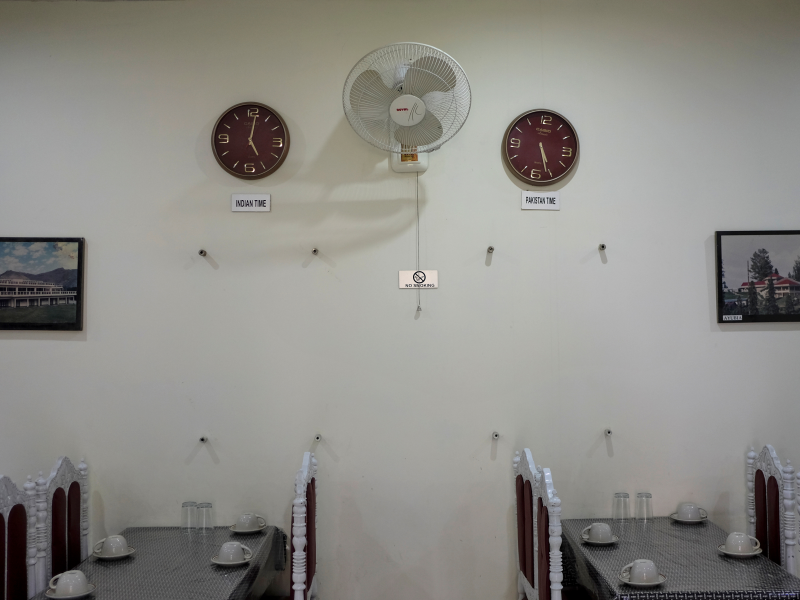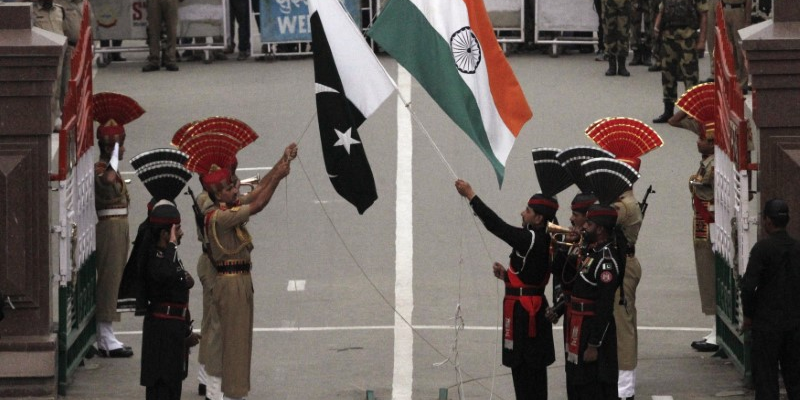- India and Pakistan were divided at the end of British colonial rule in 1947. Since then, they’ve been at odds, mostly over Kashmir, a majority-Muslim state controlled by India, Pakistan, and China.
- After three all-out wars, several border skirmishes, and terrorist attacks, Pakistan and India aren’t any closer to peaceful coexistence, and now both have nuclear weapons.
- Visit Business Insider’s home page for more stories.
The border between India and Pakistan is symbolic of decades of painful history.
The two countries were both part of British India, but colonial rule ended in 1947 and India and Pakistan were split in two, divided along religious lines by a British lawyer who hadn’t been to India before. Millions of people were displaced, and as many as one million died in the chaos and sectarian clashes following Partition.
After three all-out wars, several border skirmishes, and terror attacks, Pakistan and India aren’t any closer to peaceful co-existence; and now, both are armed with nuclear weapons.
In July, President Donald Trump falsely told Pakistani Prime Minister Imran Khan that Indian Prime Minister Narendra Modi asked him to mediate what perhaps the two countries' most acrimonious dispute - the decades-long battle over the territory of Kashmir, a majority-Muslim territory that was originally ruled by India.
While Pakistan hopes for third-party intervention in the conflict, India will only negotiate bilaterally.
Take a look at one of the world's hotspots - the border between India and Pakistan.
The border between India and Pakistan is based on the Radcliffe Line, drawn in the weeks before Partition by Sir Cyril Radcliffe, who had never been to Asia. His attempts to divide the subcontinent based on religion resulted in sectarian clashes and between 500,000 and a million people were killed.

Source: BBC, The Diplomat
India and Pakistan have fought three wars, starting almost immediately after partition. Two of the three wars were fought expressly over Kashmir. When the countries were separated during partition, the Maharajah of Jammu and Kashmir decided to become part of India, angering Pakistan, which supported several insurgencies.

Many Kashmiris hope for independence, or to be ruled by Pakistan instead of India, according to the BBC.
Residents of border towns must deal with violence between India and Pakistan, While there hasn't been an all-out war in decades, terror attacks and military engagements are not uncommon.

The border is often closed due to fighting or to terror incidents. In November 2014, for example, a Pakistani Taliban suicide bomber killed dozens at the Wagah border.

Source: BBC
The Badshahi Mosque in Lahore, in the Pakistani border state of Punjab, is the second-largest mosque in Pakistan, with a capacity of 100,000 worshipers.

Source: Atlas Obscura
Lahore Fort in Lahore's Walled City is a UNESCO World Heritage site. It has Hindu and Mughal motifs in its design and is "a unique and exceptional testimony to the Mughal civilization at the height of its artistic and aesthetic accomplishments, in the 16th and 17th centuries."

The Mughal Empire ruled parts of the Indian subcontinent starting in the early 16th century.
Source: Unesco
India's Rajasthan, which borders Pakistan, is mostly desert. It's majority Hindu, with some Muslim, Sikh, and Jain populations.

In February, about 40 Indian Central Reserve Police Force troops were killed by a car bomb. Jaish-e-Mohammed, an extremist group based in Pakistan and which aims to unite Kashmir and Pakistan, claimed responsibility for the attack. Afterward, The Indian air force conducted an exercise in Pokhran, Rajasthan.

Source: BBC
An Indian air force base in Pathankot, in the Indian state of Punjab, was attacked in 2016. A coalition of Kashmiri groups, the United Jihad Council, claimed responsibility for the attack, saying it opposed Indian rule of Kashmir.

Source: BBC
The Indian border state of Punjab is the home of the Sikh religion. Sikhism is monotheistic, and it's the fifth-largest faith in the world. Sikh men wear a turban to cover their hair, which Sikhism dictates they do not cut.

Punjab was divided during Partition; there's a Pakistani Punjab, but most Sikh live in Indian Punjab.
Source: Religion News Service
Shri Harmandir Sahib, known as the Golden Temple, is located in Amritsar, India, and is the most significant pilgrimage site for Sikhs. Shown here at night, it's located about 18 miles from the Pakistan border.

Source: Atlas Obscura
Designated terror groups, like Lakshar-e-Taiba (LeT), operate within Pakistan. LeT was blamed for a terror attack in Mumbai, India, in 2008, which killed 164 people. Hafiz Saeed, who started LeT, was arrested in Pakistan. Groups like LeT advocate the end of Indian influence in Kashmir.

Saeed has been arrested and released in Pakistan several times, most recently in July.
Source: CNN, CIA World Factbook
Kashmir is a heavily disputed between India and Pakistan. India, Pakistan, and China all control parts of Kashmir, but India controls the largest portion — 45%.

The Line of Control (LoC) divides Indian-controlled Kashmir from Pakistan-controlled Kashmir. It was set up in 1948, after India and Pakistan fought their first war over the territories of Jammu and Kashmir.

Source: BBC
The LoC is about 450 miles long and lined with barbed wire.

Source: The Wall Street Journal
A Pakistani flag is visible on a guard tower on the Pakistani side of the border between Indian Kashmir and Pakistani Kashmir.

Kashmiri Muslims often clash with Indian security forces. Protests and armed clashes occur in response to human-rights violations, including extrajudicial killings and rape, by Indian security forces, Human Rights Watch reports.

Source: Human Rights Watch
Much of Kashmir is mountainous, as the Himalaya mountain range stretches into the territory. While Kashmir is majority Muslim, there are also Hindu holy sites there, such as Amaranth cave. Hundreds of thousands of Hindus left Kashmir, or were killed in violent sectarian clashes, in the 1990s.

Source: BBC
Indian leader Narendra Modi has called for development in Kashmir. Clashes between Kashmiri groups and Indian security forces have increased under Modi, whose BJP Party promotes a Hindu nationalist message.

Source: Al Jazeera, CNBC
At a meeting with Pakistani Prime Minister Imran Khan in July, President Donald Trump falsely claimed that Modi had asked him to mediate the dispute over Kashmir.

India controls a larger portion of Kashmir, so it's in India's interest to only negotiate bilaterally with Pakistan, lest Pakistan use third-party leverage to try and gain more territory.
The Wagah-Attari and Munabao border crossings are the only places people can travel by train between India and Pakistan. Both rail services going through Wagah-Attari and Munabao have been suspended at various points in the past decade due to violence — either all-out war or terrorism.

The "friendship bus" runs between the Indian capital of New Delhi and Lahore, Pakistan every day but Sunday, carrying Indians, Pakistanis, and Kashmiris between India and Pakistan. Established in 1999, it has run through multiple conflicts between the two countries.

Source: Al Jazeera
Wagah-Attari has one of the few border crossings between Pakistan and India.

Border guards from India and Pakistan perform ceremonies at the border for audiences. A stadium expressly built for spectators of those ceremonies sits on the border.

Pakistani and Indian border guards meet at the boundary between India and Pakistan. During an evening ceremony, the guards symbolically close the gate between India and Pakistan. The entrance to Pakistan can be seen in the background.

Pakistan banned alcohol for Muslims in 1979. Here, Pakistani customs officials crush contraband bottles of alcohol at the border in January 2019.

Source
The Samjhauta Express, or Friendship Express, is one of two railway stations connecting India and Pakistan. It's one of few options for people to move between both countries, but its service was suspended during violence between the two countries in March.

When British colonial rule ended in 1947, thousands of families were separated by the partition. While they can now travel back and forth, the process is still somewhat onerous; visas to go back and forth are often delayed, and Indian nationals in Pakistan are required to check in with police upon arrival.
Source: Al Jazeera, Government of Pakistan
The gate into Pakistan at the Wagah-Attari border crossing bears the image of Mohammed Ali Jinnah, the first leader of independent Pakistan. Jinnah led the fight for a separate nation for Indian Muslims and led Pakistan from its creation until his death from tuberculosis in September 1948.

Source: BBC
The entrance to India features Mahatma Gandhi. Gandhi led the push for Indian independence from colonial Britain through peaceful resistance, including a hunger strike and what's known as the Salt Satyagraha — a 24-day march to the town of Dandi to gather Indian salt in 1930. At the time it was illegal for Indians to buy domestically harvested salt; they had to purchase salt that was processed in and imported from Britain.

Source: Time
The Wagah Stadium straddles the border between India and Pakistan.

The Wagah-Attari stadium was specially built for spectators of India and Pakistan's daily border-guard ceremony.

The rail station at Munabao is the other station linking the two countries, although it carries only passengers, not cargo. Munabao is far west of Wagah, in the state of Rajasthan. The Thar Express, the railway between the two countries, was closed for 41 years after the India-Pakistan war in 1965. Its operation is periodically reviewed by India and Pakistan; last year, it was decided it would run into 2021.

Source: Mint

